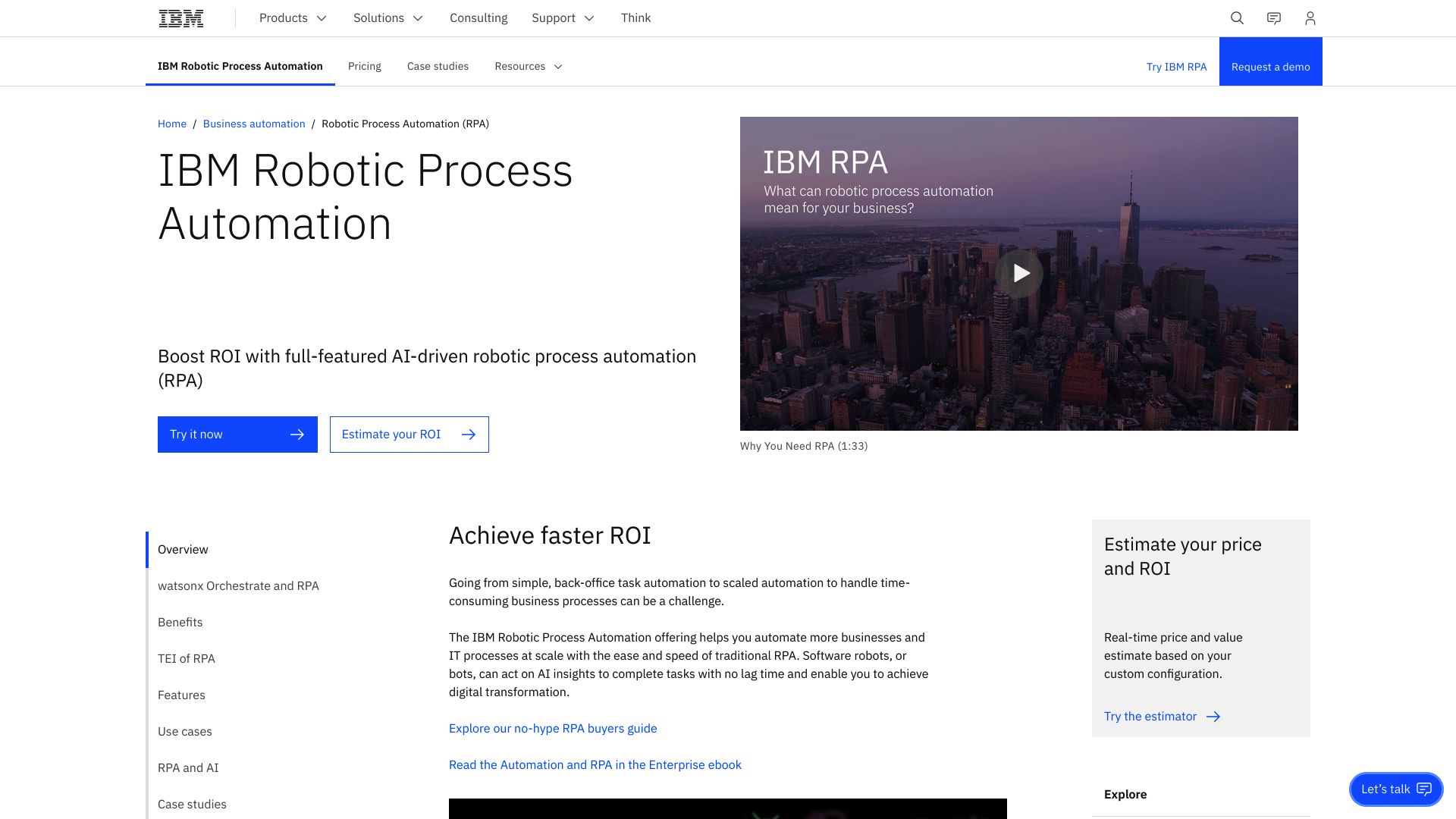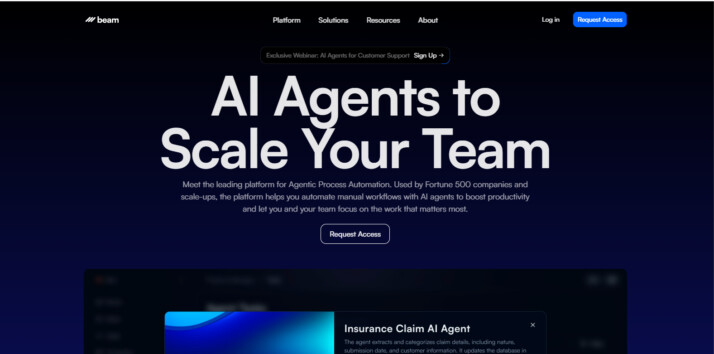IBM RPA vs. Beam AI: Comparing Enterprise and Adaptive Automation
The AI-powered automation landscape offers exciting possibilities for businesses seeking to streamline operations and boost productivity. This comparison explores three leading platforms: IBM RPA vs. Beam AI, and SmythOS. IBM RPA brings enterprise-grade automation with robust governance features, ideal for large organizations navigating complex regulatory environments. Beam AI introduces innovative Agentic Process Automations, emphasizing adaptive learning and sustainability. SmythOS emerges as a versatile solution, combining powerful AI capabilities with user-friendly tools accessible to both technical and non-technical users. We’ll examine how each platform tackles key challenges in process automation, integration, and scalability, helping you determine which solution best aligns with your organization’s unique needs and goals.
IBM RPA Overview
IBM RPA transforms business processes through intelligent automation. This enterprise-grade platform enables organizations to build, deploy, and manage software robots that mimic human actions across digital systems. IBM RPA excels at automating repetitive tasks, freeing human workers to focus on higher-value activities.
The platform’s visual builder empowers both technical and non-technical users to create automation workflows. Drag-and-drop functionality allows for rapid bot development without extensive coding. For more complex scenarios, IBM RPA supports advanced scripting and integrations with AI services like watsonx Orchestrate.
IBM RPA transforms business processes through intelligent automation… enabling organizations to build, deploy, and manage software robots that mimic human actions across digital systems.
IBM RPA provides robust governance and security features critical for enterprise deployments. The solution integrates with IBM OpenPages for comprehensive audit logging, compliance monitoring, and risk management. Data encryption and access controls safeguard sensitive information as bots interact with various systems.


IBM RPA shines in its ability to automate end-to-end business processes across diverse applications. The platform seamlessly connects with legacy systems, modern SaaS tools, and everything in between. This versatility makes it well-suited for large enterprises with complex IT landscapes.
IBM RPA shines in its ability to automate end-to-end business processes across diverse applications… connecting with legacy systems, modern SaaS tools, and everything in between.
While IBM RPA offers powerful capabilities, its enterprise focus may present a steeper learning curve for smaller organizations or individual developers. The platform’s emphasis on governance and scalability comes with added complexity compared to some lightweight alternatives. However, for businesses requiring industrial-strength automation with robust security and compliance features, IBM RPA delivers a comprehensive solution.
Beam AI Overview
Beam AI revolutionizes task automation with its innovative Agentic Process Automations (APA). These AI-powered agents streamline repetitive manual tasks, allowing organizations to redirect human efforts towards more strategic initiatives. Beam’s platform excels in automating data extraction, customer inquiry management, compliance tasks, and order processing.
The core strength of Beam AI lies in its adaptive learning capabilities. APAs continuously refine their performance, enhancing precision and efficiency over time. This self-improving functionality sets Beam apart in the competitive landscape of AI automation tools. The platform’s versatility shines in its applications across back-office operations, customer service, compliance, and order management.


Beam AI revolutionizes task automation with its innovative Agentic Process Automations (APA). These AI-powered agents streamline repetitive manual tasks, allowing organizations to redirect human efforts…
Beam AI emphasizes sustainability and efficiency in its approach. The company’s AI-native solutions minimize process steps, reducing both time and environmental impact. This aligns with Beam’s vision of a future driven by artificial general intelligence (AGI), reflecting their commitment to pushing the boundaries of AI technology.
Beam AI’s agents feature advanced conversational interfaces, facilitating seamless integration with existing systems. This enables efficient workflow planning and execution, providing a comprehensive automation solution. However, potential users should consider that while Beam offers powerful capabilities, it may require a learning curve to fully leverage its advanced features.
In the rapidly evolving AI landscape, Beam AI positions itself as a forward-thinking player. Their focus on continuous innovation and customer-centric development ensures the platform remains at the cutting edge of AI and automation technology. For organizations seeking to harness the power of AI for process optimization, Beam AI presents a compelling option worth exploring.
Feature Comparison
IBM RPA and Beam AI offer distinct approaches to process automation, each with its own strengths and limitations. IBM RPA excels in enterprise-grade automation, providing robust governance and security features critical for large organizations. Its integration with IBM OpenPages ensures comprehensive audit logging and compliance monitoring, addressing the complex needs of heavily regulated industries. In contrast, Beam AI focuses on AI-driven Agentic Process Automations (APAs), which continuously learn and adapt to enhance precision and efficiency over time.
While IBM RPA offers powerful tools for building and managing bots across various enterprise systems, it may present a steeper learning curve for smaller organizations or individual developers. Beam AI, on the other hand, emphasizes adaptive learning and sustainability, potentially offering a more accessible solution for organizations looking to minimize process steps and reduce environmental impact. However, Beam AI’s innovative approach may require users to adapt to a new paradigm of process automation.
Both platforms support multi-agent collaboration and human-AI interaction, but they differ in their core components. IBM RPA provides extensive integration with legacy systems and modern SaaS tools, making it well-suited for complex IT landscapes. Beam AI’s focus on AGI and conversational interfaces may offer more advanced natural language processing capabilities, but it may lack the breadth of pre-built integrations found in IBM’s offering. In terms of security, IBM RPA’s enterprise focus translates to more comprehensive data encryption and access controls, while Beam AI’s security features are less explicitly detailed in available information.
Feature Comparison Table
| IBM RPA | Beam AI | SmythOS | |
|---|---|---|---|
| CORE FEATURES | |||
| AI Agents | ❌ | ✅ | ✅ |
| Visual Builder | ✅ | ❌ | ✅ |
| No-Code Options | ✅ | ❌ | ✅ |
| Memory & Context | ❌ | ✅ | ✅ |
| Autonomous Agents | ❌ | ✅ | ✅ |
| Explainability & Transparency | ❌ | ✅ | ✅ |
| Debug Tools | ✅ | ❌ | ✅ |
| Multimodal | ❌ | ❌ | ✅ |
| Problem-Solving Capabilities | ❌ | ✅ | ✅ |
| Multi-Agent Collaboration | ❌ | ✅ | ✅ |
| Work as Team | ❌ | ✅ | ✅ |
| SECURITY | |||
| Constrained Alignment | ❌ | ✅ | ✅ |
| OAuth | ❌ | ✅ | ✅ |
| IP Control | ❌ | ✅ | ✅ |
| COMPONENTS | |||
| Foundation AIs | ❌ | ✅ | ✅ |
| Huggingface AIs | ❌ | ✅ | ✅ |
| Zapier APIs | ❌ | ✅ | ✅ |
| Classifiers | ❌ | ✅ | ✅ |
| Data Lakes | ❌ | ❌ | ✅ |
| DEPLOYMENT OPTIONS (EMBODIMENTS) | |||
| Deploy as Webhook | ❌ | ✅ | ✅ |
| Staging Domains | ❌ | ✅ | ✅ |
| Production Domains | ❌ | ✅ | ✅ |
| API Authentication (OAuth + Key) | ❌ | ✅ | ✅ |
| Deploy as Site Chat | ❌ | ✅ | ✅ |
| Deploy as GPT | ❌ | ✅ | ✅ |
| DATA LAKE SUPPORT | |||
| Hosted Vector Database | ❌ | ❌ | ✅ |
| Sitemap Crawler | ❌ | ❌ | ✅ |
| YouTube Transcript Crawler | ❌ | ❌ | ✅ |
| URL Crawler | ❌ | ❌ | ✅ |
Best Alternative to IBM RPA and Beam AI
SmythOS stands out as the superior alternative to IBM RPA and Beam AI, offering a comprehensive AI automation platform that combines ease of use with powerful features. Our platform empowers users to create and deploy AI agents quickly and efficiently, addressing a wide range of business needs.
Unlike IBM RPA’s focus on traditional robotic process automation, SmythOS leverages advanced AI capabilities to create intelligent agents that can adapt and learn. While Beam AI emphasizes autonomous agents, SmythOS goes further by providing a visual builder and no-code options, making AI development accessible to users of all skill levels.
SmythOS excels in its versatility, supporting multimodal interactions and offering a rich set of pre-built integrations.
SmythOS excels in its versatility, supporting multimodal interactions and offering a rich set of pre-built integrations. Our platform enables seamless deployment across various environments, from APIs and webhooks to site chats and scheduled agents. This flexibility allows businesses to implement AI solutions tailored to their specific requirements without the limitations found in IBM RPA or Beam AI.
We prioritize scalability and security, ensuring that our platform can grow with your business while maintaining data integrity. SmythOS offers features like constrained alignment and OAuth integration, addressing the complex security needs of modern enterprises. Additionally, our hosted vector database and support for diverse data sources provide a robust foundation for building sophisticated AI applications.
By choosing SmythOS, you gain access to a cutting-edge AI platform that combines the best of both worlds – the enterprise-grade capabilities of IBM RPA and the AI-driven innovation of Beam AI – all while offering superior usability and an extensive feature set. Our platform empowers you to unlock the full potential of AI automation, driving efficiency and innovation across your organization.
Conclusion
IBM RPA and Beam AI offer powerful automation solutions, each with unique strengths. IBM RPA excels in enterprise-grade deployments, providing robust governance and security features crucial for large organizations. Its seamless integration with legacy systems and modern SaaS tools makes it ideal for complex IT landscapes. Beam AI, with its innovative Agentic Process Automations, focuses on adaptive learning and sustainability, potentially offering a more accessible solution for organizations looking to minimize process steps.
However, SmythOS emerges as the superior choice, combining the best of both worlds and pushing the boundaries of AI-powered automation. Our platform’s intuitive drag-and-drop interface democratizes AI development, making it accessible to both technical and non-technical users. With support for over 300,000 integrations and compatibility with various AI models, SmythOS offers unparalleled flexibility and scalability.
Unlike IBM RPA and Beam AI, SmythOS provides a truly comprehensive solution for creating, deploying, and managing AI agents across multiple platforms. Our “Create Once, Deploy Anywhere” approach allows users to seamlessly integrate AI solutions into existing workflows, whether as APIs, chatbots, or scheduled agents. This versatility, combined with our robust security features and scalable architecture, makes SmythOS the ideal choice for businesses of all sizes looking to harness the full potential of AI automation.
We invite you to experience the future of AI-powered automation with SmythOS. Create a free account today and discover how our platform can revolutionize your workflows, boost productivity, and drive innovation in your organization. With our 30-day money-back guarantee and unlimited agent creation, there’s no risk in exploring the limitless possibilities of SmythOS. Start building your AI agents now and join the AI workforce revolution!
Last updated:
Disclaimer: The information presented in this article is for general informational purposes only and is provided as is. While we strive to keep the content up-to-date and accurate, we make no representations or warranties of any kind, express or implied, about the completeness, accuracy, reliability, suitability, or availability of the information contained in this article.
Any reliance you place on such information is strictly at your own risk. We reserve the right to make additions, deletions, or modifications to the contents of this article at any time without prior notice.
In no event will we be liable for any loss or damage including without limitation, indirect or consequential loss or damage, or any loss or damage whatsoever arising from loss of data, profits, or any other loss not specified herein arising out of, or in connection with, the use of this article.
Despite our best efforts, this article may contain oversights, errors, or omissions. If you notice any inaccuracies or have concerns about the content, please report them through our content feedback form. Your input helps us maintain the quality and reliability of our information.
